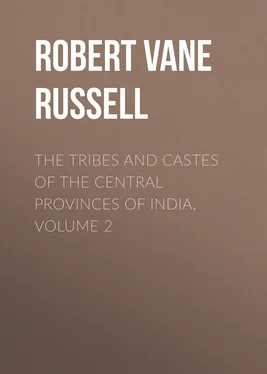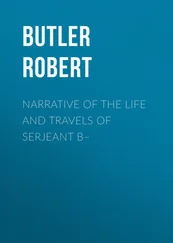Robert Vane Russell - The Tribes and Castes of the Central Provinces of India, Volume 2
Здесь есть возможность читать онлайн «Robert Vane Russell - The Tribes and Castes of the Central Provinces of India, Volume 2» — ознакомительный отрывок электронной книги совершенно бесплатно, а после прочтения отрывка купить полную версию. В некоторых случаях можно слушать аудио, скачать через торрент в формате fb2 и присутствует краткое содержание. Жанр: foreign_prose, История, foreign_edu, foreign_antique, на английском языке. Описание произведения, (предисловие) а так же отзывы посетителей доступны на портале библиотеки ЛибКат.
- Название:The Tribes and Castes of the Central Provinces of India, Volume 2
- Автор:
- Жанр:
- Год:неизвестен
- ISBN:нет данных
- Рейтинг книги:4 / 5. Голосов: 1
-
Избранное:Добавить в избранное
- Отзывы:
-
Ваша оценка:
- 80
- 1
- 2
- 3
- 4
- 5
The Tribes and Castes of the Central Provinces of India, Volume 2: краткое содержание, описание и аннотация
Предлагаем к чтению аннотацию, описание, краткое содержание или предисловие (зависит от того, что написал сам автор книги «The Tribes and Castes of the Central Provinces of India, Volume 2»). Если вы не нашли необходимую информацию о книге — напишите в комментариях, мы постараемся отыскать её.
The Tribes and Castes of the Central Provinces of India, Volume 2 — читать онлайн ознакомительный отрывок
Ниже представлен текст книги, разбитый по страницам. Система сохранения места последней прочитанной страницы, позволяет с удобством читать онлайн бесплатно книгу «The Tribes and Castes of the Central Provinces of India, Volume 2», без необходимости каждый раз заново искать на чём Вы остановились. Поставьте закладку, и сможете в любой момент перейти на страницу, на которой закончили чтение.
Интервал:
Закладка:
If a mendicant Bairāgi keeps a woman it is stated that he is expelled from the community, but this rule does not seem to be enforced in practice. If he is detected in a casual act of sexual intercourse a fine should be imposed, such as feeding two or three hundred Bairāgis. The property of an unmarried Bairāgi descends to a selected chela or disciple. The bodies of the dead are usually burnt, but those of saints specially famous for their austerities or piety are buried, and salt is put round the body to preserve it. Such men are known as Bhakta.
14. Bairāgi monasteries.
The Bairāgis 107 107 This paragraph is taken from Professor Wilson’s Account of Hindu Sects in the Asiatic Researches .
have numerous maths or monasteries, scattered over the country and usually attached to temples. The Math comprises a set of huts or chambers for the Mahant or superior and his permanent pupils; a temple and often the Samādhi or tomb of the founder, or of some eminent Mahant; and a Dharmsāla or charitable hostel for the accommodation of wandering members of the order, and of other travellers who are constantly visiting the temple. Ingress and egress are free to all, and, indeed, a restraint on personal liberty seems never to have entered into the conception of any Hindu religious legislator. There are, as a rule, a small number of resident chelas or disciples who are scholars and attendants on the superiors, and also out-members who travel over the country and return to the monastery as a headquarters. The monastery has commonly some small endowment in land, and the resident chelas go out and beg for alms for their common support. If the Mahant is married the headship may descend in his family; but when he is unmarried his successor is one of his disciples, who is commonly chosen by election at a meeting of the Mahants of neighbouring monasteries. Formerly the Hindu governor of the district would preside at such an election, but it is now, of course, left entirely to the Bairāgis themselves.
15. Married Bairāgis.
Large numbers of Bairāgis now marry and have children, and have formed an ordinary caste. The married Bairāgis are held to be inferior to the celibate mendicants, and will take food from them, but the mendicants will not permit the married Bairāgis to eat with them in the chauka or place purified for the taking of food. The customs of the married Bairāgis resemble those of ordinary Hindu castes such as the Kurmis. They permit divorce and the remarriage of widows, and burn the dead. Those who have taken to cultivation do not, as a rule, plough with their own hands. Many Bairāgis have acquired property and become landholders, and others have extensive moneylending transactions. Two such men who had acquired possession of extensive tracts of zamīndāri land in Chhattīsgarh, in satisfaction of loans made to the Gond zamīndārs, and had been given the zamīndāri status by the Marāthas, were subsequently made Feudatory Chiefs of the Nāndgaon and Chhuikhadan States. These chiefs now marry and the States descend in their families by primogeniture in the ordinary manner. As a rule, the Bairāgi landowners and moneylenders are not found to be particularly good specimens of their class.
Balāhi
1. General notice.
Balāhi. 108 108 This article is based on papers by Mr. Habīb Ullah, Pleader, Burhānpur, Mr. W. Bagley, Subdivisional Officer, and Munsh Kanhya Lāl, of the Gazetteer office.
—A low functional caste of weavers and village watchmen found in the Nimār and Hoshangābād Districts and in Central India. They numbered 52,000 persons in the Central Provinces in 1911, being practically confined to the two Districts already mentioned. The name is a corruption of the Hindi bulāhi , one who calls, or a messenger. The Balāhis seem to be an occupational group, probably an offshoot of the large Kori caste of weavers, one of whose subdivisions is shown as Balāhi in the United Provinces. In the Central Provinces they have received accretions from the spinner caste of Katias, themselves probably a branch of the Koris, and from the Mahārs, the great menial caste of Bombay. In Hoshangābād they are known alternatively as Mahār, while in Burhānpur they are called Bunkar or weaver by outsiders. The following story which they tell about themselves also indicates their mixed origin. They say that their ancestors came to Nimār as part of the army of Rāja Mān of Jodhpur, who invaded the country when it was under Muhammadan rule. He was defeated, and his soldiers were captured and ordered to be killed. 109 109 This legend is probably a vague reminiscence of the historical fact that a Mālwa army was misled by a Gond guide in the Nimār forests and cut up by the local Muhammadan ruler. The well-known Rāja Mān of Jodhpur was, it is believed, never in Nimār.
One of the Balāhis among them won the favour of the Muhammadan general and asked for his own freedom and that of the other Balāhis from among the prisoners. The Musalmān replied that he would be unable to determine which of the prisoners were really Balāhis. On this the Balāhi, whose name was Ganga Kochla, replied that he had an effective test. He therefore killed a cow, cooked its flesh and invited the prisoners to partake of it. So many of them as consented to eat were considered to be Balāhis and liberated; but many members of other castes thus obtained their freedom, and they and their descendants are now included in the community. The subcastes or endogamous groups distinctly indicate the functional character of the caste, the names given being Nimāri, Gannore, Katia, Kori and Mahār. Of these Katia, Kori and Mahār are the names of distinct castes, Nimāri is a local subdivision indicating those who speak the peculiar dialect of this tract, and the Gannore are no doubt named after the Rājpūt clan of that name, of whom their ancestors were not improbably the illegitimate offspring. The Nimāri Balāhis are said to rank lower than the rest, as they will eat the flesh of dead cattle which the others refuse to do. They may not take water from the village well, and unless a separate one can be assigned to them, must pay others to draw water for them. Partly no doubt in the hope of escaping from this degraded position, many of the Nimāri group became Christians in the famine of 1897. They are considered to be the oldest residents of Nimār. At marriages the Balāhi receives as his perquisite the leaf-plates used for feasts with the leavings of food upon them; and at funerals he takes the cloth which covers the corpse on its way to the burning- ghāt . In Nimār the Korkus and Balāhis each have a separate burying-ground which is known as Murghāta. 110 110 The ghāt or river-bank for the disposal of corpses.
The Katias weave the finer kinds of cloth and rank a little higher than the others. In Burhānpur, as already stated, the caste are known as Bunkar, and they are probably identical with the Bunkars of Khāndesh; Bunkar is simply an occupational term meaning a weaver.
2. Marriage.
The caste have the usual system of exogamous groups, some of which are named after villages, while the designations of others are apparently nicknames given to the founder of the clan, as Bagmār, a tiger-killer, Bhagoria, a runaway, and so on. They employ a Brāhman to calculate the horoscopes of a bridal couple and fix the date of their wedding, but if he says the marriage is inauspicious, they merely obtain the permission of the caste panchāyat and celebrate it on a Saturday or Sunday. Apparently, however, they do not consult real Brāhmans, but merely priests of their own caste whom they call Balāhi Brāhmans. These Brāhmans are, nevertheless, said to recite the Satya Nārāyan Katha. They also have gurus or spiritual preceptors, being members of the caste who have joined the mendicant orders; and Bhāts or genealogists of their own caste who beg at their weddings. They have the practice of serving for a wife, known as Gharjamai or Lamjhana. When the pauper suitor is finally married at the expense of his wife’s father, a marriage-shed is erected for him at the house of some neighbour, but his own family are not invited to the wedding.
Читать дальшеИнтервал:
Закладка:
Похожие книги на «The Tribes and Castes of the Central Provinces of India, Volume 2»
Представляем Вашему вниманию похожие книги на «The Tribes and Castes of the Central Provinces of India, Volume 2» списком для выбора. Мы отобрали схожую по названию и смыслу литературу в надежде предоставить читателям больше вариантов отыскать новые, интересные, ещё непрочитанные произведения.
Обсуждение, отзывы о книге «The Tribes and Castes of the Central Provinces of India, Volume 2» и просто собственные мнения читателей. Оставьте ваши комментарии, напишите, что Вы думаете о произведении, его смысле или главных героях. Укажите что конкретно понравилось, а что нет, и почему Вы так считаете.












